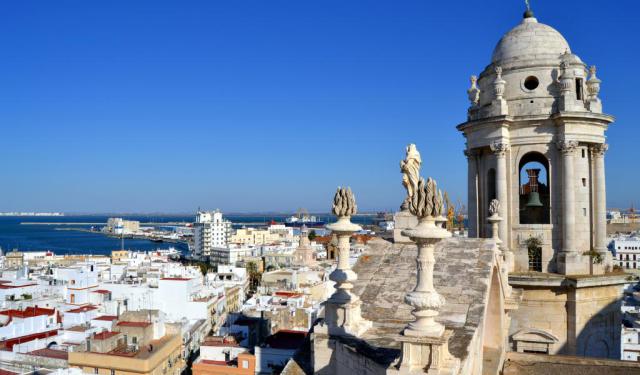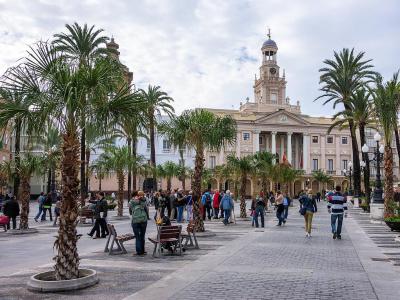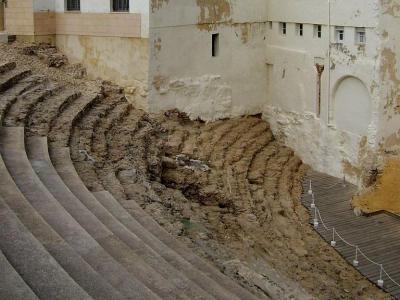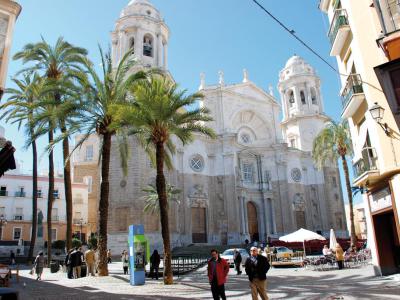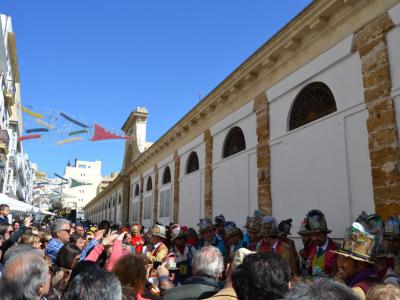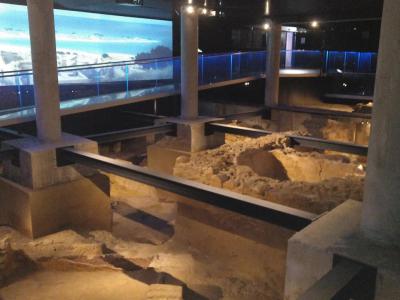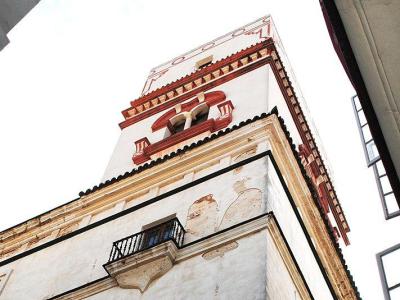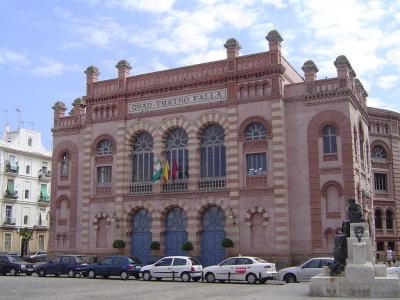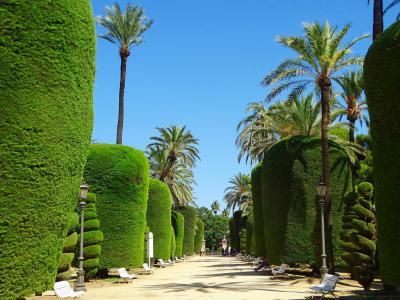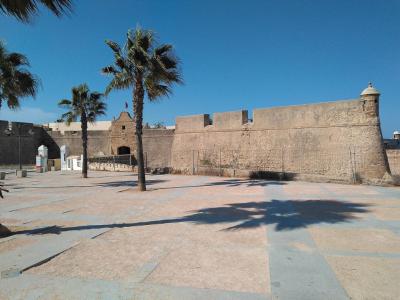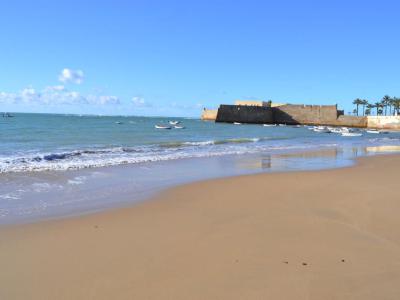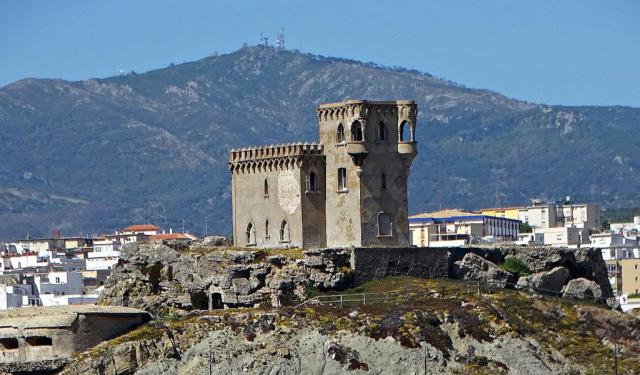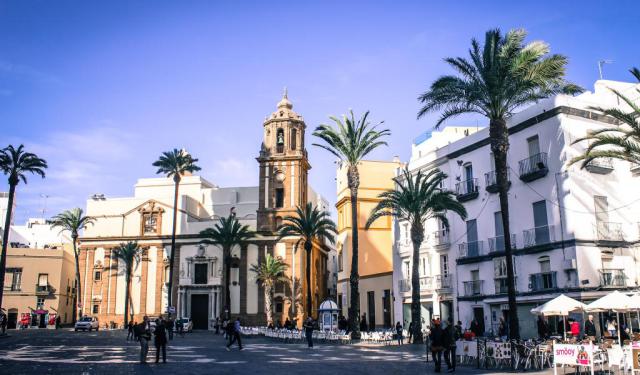Audio Guide: Cadiz Introduction Walking Tour (Self Guided), Cadiz
Cádiz isn’t just old-it’s mythologically old. Some say Hercules himself founded the city after his tenth labor, fresh from slaying a three-headed monster and stealing a herd of red cattle. Others-less into mythology, more into maritime records-say it was the Phoenicians who rolled up in black ships around 1100 BC and named it Gadir, meaning “walled stronghold.” Either way, it’s been here a while.
Over the centuries, Cádiz has been traded like a prized shell among civilizations: Carthaginians, Romans, Visigoths, Byzantines, Moors, and finally Castilian Spain under Alfonso X. In the 18th century, Cádiz hit peak relevance as the only Spanish port allowed to trade with the Americas-until 1778, when other ports were let into the club. Still, the city’s legacy as a gateway between continents lingers in its bones and baroque balconies.
The Old Town is a maze of narrow, twisting alleys that seem to conspire against maps, leading you to wide, sunlit plazas. Saint John of God Square is a perfect starting point, with its palm trees, fountains, and a town hall that mixes neoclassical order with Gothic flair. Just a few steps away lies the Roman Theatre, a 1st-century structure buried for centuries-classic Cádiz, hiding ancient wonders beneath modern life.
The city is famously dotted with over 160 towers, but none quite like Tavira Tower, once the official lookout. Climb it for a rooftop view and a real-time tour via the Dark Room, like a live-action globe that spins just for you.
Step even deeper into the past at Gadir Archaeological Site, where glass walkways let you peer down at preserved Phoenician streets-like a fish-eye view of 3,000-year-old urban planning. Then it’s back up to modern level for markets, flamenco, and coffee breaks.
Speaking of culture, Grand Theatre Falla is where Moorish Revival meets Spanish drama, while Genovés Park offers waterfalls, exotic plants, and a break from your step count. Flanked by two star-shaped guardians-Castle of Saint Catalina and Castle of Saint Sebastián-you’ll find La Caleta Beach, where sunsets are a local event, and fishing lines blend with camera flashes.
Hungry? You’re in luck. Central Market is a feast of seafood, produce, and tapas, while nearby streets overflow with tree-shaded tables and locals who’ve made eating an art form. Don’t skip Cadiz Cathedral, with its golden dome and a square that pulses with life, music, and the occasional flamenco flash mob.
Cádiz is a city of stories told in stone, sea air, and song. All that’s missing is you-comfortable shoes, open mind, maybe a sunhat. Let the past walk beside you. It usually knows the way.
Over the centuries, Cádiz has been traded like a prized shell among civilizations: Carthaginians, Romans, Visigoths, Byzantines, Moors, and finally Castilian Spain under Alfonso X. In the 18th century, Cádiz hit peak relevance as the only Spanish port allowed to trade with the Americas-until 1778, when other ports were let into the club. Still, the city’s legacy as a gateway between continents lingers in its bones and baroque balconies.
The Old Town is a maze of narrow, twisting alleys that seem to conspire against maps, leading you to wide, sunlit plazas. Saint John of God Square is a perfect starting point, with its palm trees, fountains, and a town hall that mixes neoclassical order with Gothic flair. Just a few steps away lies the Roman Theatre, a 1st-century structure buried for centuries-classic Cádiz, hiding ancient wonders beneath modern life.
The city is famously dotted with over 160 towers, but none quite like Tavira Tower, once the official lookout. Climb it for a rooftop view and a real-time tour via the Dark Room, like a live-action globe that spins just for you.
Step even deeper into the past at Gadir Archaeological Site, where glass walkways let you peer down at preserved Phoenician streets-like a fish-eye view of 3,000-year-old urban planning. Then it’s back up to modern level for markets, flamenco, and coffee breaks.
Speaking of culture, Grand Theatre Falla is where Moorish Revival meets Spanish drama, while Genovés Park offers waterfalls, exotic plants, and a break from your step count. Flanked by two star-shaped guardians-Castle of Saint Catalina and Castle of Saint Sebastián-you’ll find La Caleta Beach, where sunsets are a local event, and fishing lines blend with camera flashes.
Hungry? You’re in luck. Central Market is a feast of seafood, produce, and tapas, while nearby streets overflow with tree-shaded tables and locals who’ve made eating an art form. Don’t skip Cadiz Cathedral, with its golden dome and a square that pulses with life, music, and the occasional flamenco flash mob.
Cádiz is a city of stories told in stone, sea air, and song. All that’s missing is you-comfortable shoes, open mind, maybe a sunhat. Let the past walk beside you. It usually knows the way.
How it works: Download the app "GPSmyCity: Walks in 1K+ Cities" from Apple App Store or Google Play Store to your mobile phone or tablet. The app turns your mobile device into a personal tour guide and its built-in GPS navigation functions guide you from one tour stop to next. The app works offline, so no data plan is needed when traveling abroad.
Cadiz Introduction Walking Tour Map
Guide Name: Cadiz Introduction Walking Tour
Guide Location: Spain » Cadiz (See other walking tours in Cadiz)
Guide Type: Self-guided Walking Tour (Sightseeing)
# of Attractions: 10
Tour Duration: 2 Hour(s)
Travel Distance: 2.8 Km or 1.7 Miles
Author: DanaOffice
Sight(s) Featured in This Guide:
Guide Location: Spain » Cadiz (See other walking tours in Cadiz)
Guide Type: Self-guided Walking Tour (Sightseeing)
# of Attractions: 10
Tour Duration: 2 Hour(s)
Travel Distance: 2.8 Km or 1.7 Miles
Author: DanaOffice
Sight(s) Featured in This Guide:
- Plaza de San Juan de Dios (Saint John of God Square) and Old Town Hall
- Teatro Romano (Roman Theatre)
- Cadiz Cathedral and Square
- Mercado Central (Central Market)
- Yacimiento Arqueologico Gadir (Gadir Archaeological Site)
- Torre Tavira (Tavira Tower)
- Gran Teatro Falla (Grand Theatre Falla)
- Parque Genoves (Genoves Park)
- Castillo de Santa Catalina (Castle of Santa Catalina)
- Playa de La Caleta (La Caleta Beach)
1) Plaza de San Juan de Dios (Saint John of God Square) and Old Town Hall
Saint John of God Square-or as locals call it, La Corredera-is Cádiz’s front porch, living room, and civic stage all rolled into one. Originally laid out in the 15th century, when Columbus was still just doodling ship ideas, the square was built just outside the old city walls. Back then, Cádiz was a cluster of sandy islands, and this area was a sea-splashed stretch of reclaimed land.
Entry came via the sea-facing gate, now charmingly known as the Arch of the People-because nothing says “democratic access” like a once-fortified gateway.
By the 18th century, things were getting crowded, and the old Consistorial Houses-essentially the city’s early bureaucratic digs-were torn down to make way for something a bit grander. The current Town Hall took shape, with a Neoclassical heart and, in 1865, a bit of Gothic flair. Moreover, an Isabelline-style façade was added, topped with a pediment that features none other than Hercules, flexing his mythological credentials as the alleged founder of Gadeira-Cádiz’s ancient alter ego.
And if that name sounds old, it should. By the time Hannibal showed up during the Second Punic War (218 to 201 BC), Cádiz was already centuries into its coastal career. As far as ancient cities go, Cádiz doesn’t just have history-it remembers it.
Today, the square is less about defending the harbor and more about sipping coffee under the palms while the Town Hall keeps an eye on things-just as it’s done for generations.
Entry came via the sea-facing gate, now charmingly known as the Arch of the People-because nothing says “democratic access” like a once-fortified gateway.
By the 18th century, things were getting crowded, and the old Consistorial Houses-essentially the city’s early bureaucratic digs-were torn down to make way for something a bit grander. The current Town Hall took shape, with a Neoclassical heart and, in 1865, a bit of Gothic flair. Moreover, an Isabelline-style façade was added, topped with a pediment that features none other than Hercules, flexing his mythological credentials as the alleged founder of Gadeira-Cádiz’s ancient alter ego.
And if that name sounds old, it should. By the time Hannibal showed up during the Second Punic War (218 to 201 BC), Cádiz was already centuries into its coastal career. As far as ancient cities go, Cádiz doesn’t just have history-it remembers it.
Today, the square is less about defending the harbor and more about sipping coffee under the palms while the Town Hall keeps an eye on things-just as it’s done for generations.
2) Teatro Romano (Roman Theatre)
The Roman Theatre of Cádiz-also known as the Balbi Theatre-is proof that even in ancient times, Cádiz knew how to put on a show. Unearthed in 1980 after centuries of playing hide-and-seek beneath the medieval city, this 1st-century BC structure was built around 70 BC, back when the Roman Empire was still figuring out how to get the better of the Greeks.
The brains (and probably the ego) behind it? Lucius Cornelius Balbus the Elder, a Cádiz-born Roman politician, friend of Julius Caesar. Along with his nephew, Balbus the Younger, he had big dreams of expanding Gades-today’s Cádiz-into a gleaming Neapolis, or “New City.” So far, we’ve found their theatre and signs of an amphitheater, suggesting these guys were building more than just infrastructure-they were building a vibe.
By the end of the 3rd century AD, though, the curtain had dropped. The theatre was abandoned, and over time it was scavenged for stone, turned into a stable, a storehouse, and even a medieval apartment complex. Eventually, the ruins became the foundation for a Moorish fort aptly called the Castle of the Theatre-because sometimes history just layers itself like a lasagna.
Even partially excavated, this site is considered one of the oldest and possibly the largest Roman theatres in Spain. It features a classic horseshoe-shaped auditorium with parabolic tiered seating and a vaulted distribution gallery hidden beneath. The outer wall, made from finely cut ashlar stone, it's as imposing as ever.
The modern Theatre Visitors' Center is your backstage pass to the past. Inside, you’ll find detailed models and exhibits covering three acts: the Theatre of Neapolis, the Castle of the Theatre, and the original Theatre of Balbus. Spoiler: there’s no popcorn, but the ruins do all the storytelling you need.
The brains (and probably the ego) behind it? Lucius Cornelius Balbus the Elder, a Cádiz-born Roman politician, friend of Julius Caesar. Along with his nephew, Balbus the Younger, he had big dreams of expanding Gades-today’s Cádiz-into a gleaming Neapolis, or “New City.” So far, we’ve found their theatre and signs of an amphitheater, suggesting these guys were building more than just infrastructure-they were building a vibe.
By the end of the 3rd century AD, though, the curtain had dropped. The theatre was abandoned, and over time it was scavenged for stone, turned into a stable, a storehouse, and even a medieval apartment complex. Eventually, the ruins became the foundation for a Moorish fort aptly called the Castle of the Theatre-because sometimes history just layers itself like a lasagna.
Even partially excavated, this site is considered one of the oldest and possibly the largest Roman theatres in Spain. It features a classic horseshoe-shaped auditorium with parabolic tiered seating and a vaulted distribution gallery hidden beneath. The outer wall, made from finely cut ashlar stone, it's as imposing as ever.
The modern Theatre Visitors' Center is your backstage pass to the past. Inside, you’ll find detailed models and exhibits covering three acts: the Theatre of Neapolis, the Castle of the Theatre, and the original Theatre of Balbus. Spoiler: there’s no popcorn, but the ruins do all the storytelling you need.
3) Cadiz Cathedral and Square (must see)
The 18th century was Cádiz’s golden era-literally. Gold from the Americas was flowing in, wigs were high, and civic pride was even higher. So naturally, the city decided it needed a cathedral that didn’t just rival Seville’s-it had to outshine the Giralda, Seville's precious tower.
After the original architect stormed off in 1739, a tag-team of architects spanning nearly a century followed, each adding their own stylistic flair. The result was a cathedral that pirouettes from Baroque to Rococo to Neoclassical like it couldn’t make up its mind. Surprisingly or not, the cathedral ended up looking fabulous.
The layout follows the traditional cross shape, with three main aisles and a walkway that curves around the altar like a quiet loop. Rows of polished Corinthian columns hold up elegant vaulted ceilings, and there's a crypt downstairs big enough to make any vampire rethink retirement. The altar sits high and proud, commanding your gaze, while above it all, a dome crowns the space like a golden exclamation mark. And in the choir loft? Not one, but two powerful organs-more than enough to fill the church (and your spine) with musical thunder.
Nevertheless, the main showpiece is the Clock Tower, also known as the Levante Tower. Standing at 184 feet tall, it’s your best bet for sweeping views of the El Pópulo district, the Field of the South, and the harbor, with the Atlantic winking in the distance.
The Cathedral Square outside wasn’t always so open and grand-it was created during Cádiz’s 1721 urban makeover, which included demolishing a few modest houses to make room for this dramatic entrance. The square runs along the seafront and is paved in white marble, because if you're going to build a cathedral this extra, your plaza needs to match.
Don't miss the Rose Arch, which once led to the old Tablas Square and now serves as a charming pass-through to the Town Castle. Within the square itself, you’ll also find the Church of Santa Cruz (the old cathedral from 1669) and the Jesuit Church of Santiago, built in 1563 and still standing tall.
After the original architect stormed off in 1739, a tag-team of architects spanning nearly a century followed, each adding their own stylistic flair. The result was a cathedral that pirouettes from Baroque to Rococo to Neoclassical like it couldn’t make up its mind. Surprisingly or not, the cathedral ended up looking fabulous.
The layout follows the traditional cross shape, with three main aisles and a walkway that curves around the altar like a quiet loop. Rows of polished Corinthian columns hold up elegant vaulted ceilings, and there's a crypt downstairs big enough to make any vampire rethink retirement. The altar sits high and proud, commanding your gaze, while above it all, a dome crowns the space like a golden exclamation mark. And in the choir loft? Not one, but two powerful organs-more than enough to fill the church (and your spine) with musical thunder.
Nevertheless, the main showpiece is the Clock Tower, also known as the Levante Tower. Standing at 184 feet tall, it’s your best bet for sweeping views of the El Pópulo district, the Field of the South, and the harbor, with the Atlantic winking in the distance.
The Cathedral Square outside wasn’t always so open and grand-it was created during Cádiz’s 1721 urban makeover, which included demolishing a few modest houses to make room for this dramatic entrance. The square runs along the seafront and is paved in white marble, because if you're going to build a cathedral this extra, your plaza needs to match.
Don't miss the Rose Arch, which once led to the old Tablas Square and now serves as a charming pass-through to the Town Castle. Within the square itself, you’ll also find the Church of Santa Cruz (the old cathedral from 1669) and the Jesuit Church of Santiago, built in 1563 and still standing tall.
4) Mercado Central (Central Market) (must see)
Once just a humble farmers' market, the Central Market of Cádiz decided to upgrade in the late 1890s. Enter Torcuato Benjumeda, the city’s go-to architect (he also did the Town Hall and the Church of Saint Joseph, no big deal), who designed the new market like a Roman forum with snacks: an open quadrangle lined with sturdy Doric columns, giving grocery shopping a touch of classical solemnity.
Part of the market was built right over the old Convent of the Shoeless-so while you're picking out seafood, you're also standing on a bit of sacred ground. That central space is now the main pavilion, flanked by two additional columned wings added to keep up with the city’s growing appetite for produce.
A major facelift in the early 2000s brought the market into the modern era without losing its historic charm. Today, there are over 170 stalls hawking everything from fresh seafood to baked goods, vegetables, meat, and just enough quirky side stands to keep you guessing-yes, you can pick up pickles, paper bags, and fishing gear, all in one go.
The central pavilion is a seafood lover’s dream, with counters piled high with octopus, tuna, shrimp, and whatever else the Atlantic decided to deliver that morning. Step into the left wing, and you’ll find the Gastronomic Corner, a foodie haven where locals and tourists alike graze on Cádiz’s greatest hits. The right wing leans carnivorous, featuring butchers and the occasional oddball veggie stand.
List of highlights from the tasting lineup that are worth trying out are: El Comado does wine and meats like it’s hosting your birthday party. La Tapería de Luna serves up soups and tapas that feel like home. Gadisushi delivers Japanese precision with Andalusian flair. Gadesbeer keeps things hoppy. La Sartén takes eggs and tortillas seriously. And Queso 360? Cheese from every corner of the planet.
The Central Market is a culinary microcosm of Cádiz, dressed in columns and ready to feed you.
Part of the market was built right over the old Convent of the Shoeless-so while you're picking out seafood, you're also standing on a bit of sacred ground. That central space is now the main pavilion, flanked by two additional columned wings added to keep up with the city’s growing appetite for produce.
A major facelift in the early 2000s brought the market into the modern era without losing its historic charm. Today, there are over 170 stalls hawking everything from fresh seafood to baked goods, vegetables, meat, and just enough quirky side stands to keep you guessing-yes, you can pick up pickles, paper bags, and fishing gear, all in one go.
The central pavilion is a seafood lover’s dream, with counters piled high with octopus, tuna, shrimp, and whatever else the Atlantic decided to deliver that morning. Step into the left wing, and you’ll find the Gastronomic Corner, a foodie haven where locals and tourists alike graze on Cádiz’s greatest hits. The right wing leans carnivorous, featuring butchers and the occasional oddball veggie stand.
List of highlights from the tasting lineup that are worth trying out are: El Comado does wine and meats like it’s hosting your birthday party. La Tapería de Luna serves up soups and tapas that feel like home. Gadisushi delivers Japanese precision with Andalusian flair. Gadesbeer keeps things hoppy. La Sartén takes eggs and tortillas seriously. And Queso 360? Cheese from every corner of the planet.
The Central Market is a culinary microcosm of Cádiz, dressed in columns and ready to feed you.
5) Yacimiento Arqueologico Gadir (Gadir Archaeological Site)
As a reminder, Cádiz is ancient-with-receipts old. By the time Hannibal was packing up elephants for the Second Punic War, Cádiz had already been around for about 700 years. That’s right-while much of Europe was still figuring out the wheel, the Phoenicians had settled here, around 1000 BC. They called it Gadir, which went on to become part of the “Phoenician Belt” encircling the Strait of Gibraltar-basically the VIP section of ancient Mediterranean trade.
Fast forward a few thousand years and cue the surprise twist: during routine renovations of the Noricum Puppet Theatre, someone hit archaeological gold. In 2014, the newly uncovered Gadir Archaeological Site was opened to the public, instantly becoming one of Cádiz’s most jaw-dropping attractions. It’s located on what was once the highest point of ancient Erytheia-the smallest island in the Cádiz archipelago and, apparently, the perfect place to bury history under a puppet stage.
Today, Gadir is a museum-meets-time machine. The site is cleverly organized into layers of history, with bilingual guides and glass walkways that let you literally walk over 3,000 years of city life without tripping over the past. From above, you can peer into two levels of remains. The lower level reveals eight Phoenician homes and streets, still holding onto their layout like it’s 900 BC and nothing’s changed but the tourists.
The upper level serves up Roman-era life: a fish-processing factory (because even back then, Cádiz had strong seafood game), a fabric-dyeing workshop, and a cistern-all from the 2nd century BC. Oh, and then there’s Mattan-the nickname for a young man whose skeleton was found in a house destroyed by fire in the 7th century BC. His story is truly tragic, but his nickname – legendary.
Cadiz is showing off at this point. You came for the beaches and the tapas; you stayed because the sidewalk cracked open and said, “Hey, want to see what we were doing three millennia ago?”
Fast forward a few thousand years and cue the surprise twist: during routine renovations of the Noricum Puppet Theatre, someone hit archaeological gold. In 2014, the newly uncovered Gadir Archaeological Site was opened to the public, instantly becoming one of Cádiz’s most jaw-dropping attractions. It’s located on what was once the highest point of ancient Erytheia-the smallest island in the Cádiz archipelago and, apparently, the perfect place to bury history under a puppet stage.
Today, Gadir is a museum-meets-time machine. The site is cleverly organized into layers of history, with bilingual guides and glass walkways that let you literally walk over 3,000 years of city life without tripping over the past. From above, you can peer into two levels of remains. The lower level reveals eight Phoenician homes and streets, still holding onto their layout like it’s 900 BC and nothing’s changed but the tourists.
The upper level serves up Roman-era life: a fish-processing factory (because even back then, Cádiz had strong seafood game), a fabric-dyeing workshop, and a cistern-all from the 2nd century BC. Oh, and then there’s Mattan-the nickname for a young man whose skeleton was found in a house destroyed by fire in the 7th century BC. His story is truly tragic, but his nickname – legendary.
Cadiz is showing off at this point. You came for the beaches and the tapas; you stayed because the sidewalk cracked open and said, “Hey, want to see what we were doing three millennia ago?”
6) Torre Tavira (Tavira Tower) (must see)
The Tavira Tower isn’t just another old lookout-it’s Cádiz’s version of a rooftop with a 300-year-old guest list. At 149 feet above sea level, it holds the title of tallest spot in the Old City, giving anyone at the top a serious advantage in the 18th-century game of “What ship is that?”
Originally part of The Palace of the Marquises of Recaño , the tower came with all the aristocratic bells and whistles. Cádiz was booming from its trade with the Americas and needed more than your average harbor patrol. All of this resulted in a skyline punctuated by over 126 watchtowers, with Tavira Tower sitting at the very top.
Built in 1780, Tavira Tower was always meant to be the city’s official lookout. And who better to man the post than Don Antonio Tavira, the first watchman and the man who gave the tower its name? He didn’t just climb the stairs-he left a legacy.
Today, Tavira Tower still keeps an eye on things-with a twist. Step into the Camera Obscura, and a guide will darken the room and light up your curiosity. Thanks to an old-school optical system (think spy tech meets science fair), real-time images of the city and sea are projected onto a circular table. It’s like Google Earth, but powered by mirrors and 18th-century ingenuity. The show lasts about 20 minutes, long enough to be amazed but short enough to still grab a tapa afterward.
The other rooms of the tower house exhibitions on Cádiz’s golden age, the evolution of the camera obscura, and a star-studded chapter on Spain’s 1812 Constitution-yes, the country’s very first, penned right here in Cádiz.
So climb up, squint out, and time-travel a little. Tavira Tower offers the best views in town-and not just the physical kind.
Originally part of The Palace of the Marquises of Recaño , the tower came with all the aristocratic bells and whistles. Cádiz was booming from its trade with the Americas and needed more than your average harbor patrol. All of this resulted in a skyline punctuated by over 126 watchtowers, with Tavira Tower sitting at the very top.
Built in 1780, Tavira Tower was always meant to be the city’s official lookout. And who better to man the post than Don Antonio Tavira, the first watchman and the man who gave the tower its name? He didn’t just climb the stairs-he left a legacy.
Today, Tavira Tower still keeps an eye on things-with a twist. Step into the Camera Obscura, and a guide will darken the room and light up your curiosity. Thanks to an old-school optical system (think spy tech meets science fair), real-time images of the city and sea are projected onto a circular table. It’s like Google Earth, but powered by mirrors and 18th-century ingenuity. The show lasts about 20 minutes, long enough to be amazed but short enough to still grab a tapa afterward.
The other rooms of the tower house exhibitions on Cádiz’s golden age, the evolution of the camera obscura, and a star-studded chapter on Spain’s 1812 Constitution-yes, the country’s very first, penned right here in Cádiz.
So climb up, squint out, and time-travel a little. Tavira Tower offers the best views in town-and not just the physical kind.
7) Gran Teatro Falla (Grand Theatre Falla)
Manuel de Falla y Matheu, Cádiz-born and 20th-century maestro of Spanish music, famously never came home. After Franco’s rise to power in the 1930s, Falla packed his piano and fled to Argentina. The new regime tried wooing him back with flattery and offers, but Falla wasn’t buying it. He died in exile, unmoved by dictatorship or diplomacy.
The city didn’t take it personally. In fact, Cádiz had already renamed its main theater after him in 1926, when Manuel was basking in the glow of national fame. Before that, it was simply known as the Gran Teatro, pretty modest.
The Grand Theatre Falla is a Neo-Mudéjar marvel, with three proud horseshoe arch entrances dressed in red-and-white stripes like a particularly festive candy cane. Inside, staircases swirl up toward U-shaped balconies, and above it all hovers an allegorical ceiling painting of Paradise-because if you’re not looking at the stage, you might as well look at heaven.
Each February, the theater transforms into the sparkling, satirical heart of the Cádiz Carnival, where performances are sharp, funny, and occasionally outrageous. The rest of the year, it keeps the spotlight going with concerts, plays, and enough drama to satisfy even the ghost of Manuel de Falla-who may not have come back in body, but surely lingers in spirit backstage.
The city didn’t take it personally. In fact, Cádiz had already renamed its main theater after him in 1926, when Manuel was basking in the glow of national fame. Before that, it was simply known as the Gran Teatro, pretty modest.
The Grand Theatre Falla is a Neo-Mudéjar marvel, with three proud horseshoe arch entrances dressed in red-and-white stripes like a particularly festive candy cane. Inside, staircases swirl up toward U-shaped balconies, and above it all hovers an allegorical ceiling painting of Paradise-because if you’re not looking at the stage, you might as well look at heaven.
Each February, the theater transforms into the sparkling, satirical heart of the Cádiz Carnival, where performances are sharp, funny, and occasionally outrageous. The rest of the year, it keeps the spotlight going with concerts, plays, and enough drama to satisfy even the ghost of Manuel de Falla-who may not have come back in body, but surely lingers in spirit backstage.
8) Parque Genoves (Genoves Park) (must see)
Genovés Park is the Old City's answer to “How green can you get?”-a leafy, 30,000-square-meter escape hatch from Cádiz’s cobbled ocean. Born in 1892 and holding the title of “biggest urban oasis” until Celestino Mutis Park snatched the crown in 2012, it still reigns supreme in charm and botanical bragging rights.
Back in the day, this patch of land was charmingly known as the “Walk of Parsley”-a windswept military no-man’s-land wedged between the barracks of Composanto and La Bomba. Not exactly picnic material. That all changed when someone had the bright idea to swap soldiers for shrubbery. Today, visitors enter through Rocío Jurado Square and stroll down an avenue flanked by manicured flowerbeds.
And what flowerbeds! Nestled between date palms and cypress trees, oyster stone fountains gurgle away, surrounded by over 150 species of exotic flora. There’s a Canary Islands dragon tree looking mildly suspicious, a New Zealand Christmas tree flexing its floral muscles, and a Monkey Puzzle Tree that seems just as confused as everyone else.
Kids love the whimsical waterfall, grotto, and the delightfully odd “Children Under the Umbrella” sculpture. Bronze tributes also abound: from local legend Manuel de Falla to Trafalgar’s epic sea squabble, this park doesn’t skimp on cultural seasoning.
With wrought-iron gates, Victorian-style lampposts, and a kiosk straight out of a Dickens novel, Genovés Park is part garden, part time machine. Don’t miss the open-air José María Pemán Summer Theatre, where Cádiz’s drama queens (and kings) take to the stage under the stars.
Back in the day, this patch of land was charmingly known as the “Walk of Parsley”-a windswept military no-man’s-land wedged between the barracks of Composanto and La Bomba. Not exactly picnic material. That all changed when someone had the bright idea to swap soldiers for shrubbery. Today, visitors enter through Rocío Jurado Square and stroll down an avenue flanked by manicured flowerbeds.
And what flowerbeds! Nestled between date palms and cypress trees, oyster stone fountains gurgle away, surrounded by over 150 species of exotic flora. There’s a Canary Islands dragon tree looking mildly suspicious, a New Zealand Christmas tree flexing its floral muscles, and a Monkey Puzzle Tree that seems just as confused as everyone else.
Kids love the whimsical waterfall, grotto, and the delightfully odd “Children Under the Umbrella” sculpture. Bronze tributes also abound: from local legend Manuel de Falla to Trafalgar’s epic sea squabble, this park doesn’t skimp on cultural seasoning.
With wrought-iron gates, Victorian-style lampposts, and a kiosk straight out of a Dickens novel, Genovés Park is part garden, part time machine. Don’t miss the open-air José María Pemán Summer Theatre, where Cádiz’s drama queens (and kings) take to the stage under the stars.
9) Castillo de Santa Catalina (Castle of Santa Catalina)
In 1596, Cádiz found itself on the wrong end of a very bad visit from the Anglo-Dutch party crashers led by the Duke of Essex and Admiral Howard. These weren’t your average tourists-they looted the city, torched the Spanish fleet, and left Cádiz smoldering in ruins. The damage was so severe that Spain, quite literally, went broke the next year. Oops.
One witty chronicler summed it up best: Spain had “all heads of command and none were feet that would follow.” In short: too many bosses, not enough hustle. King Philip, less than amused, launched not one but two more armadas in a fit of salty vengeance. Both failed. Cádiz was still in pieces. But out of the ashes came something solid: hope. And hope, as it turns out, looked a lot like a fortress.
Construction of the Castle of Santa Catalina began in 1598, part therapy, part defense strategy. The original design came from Cristóbal de Rojas. Sadly, Rojas didn’t live to see it finished; that job went to Ignacio de Sala, who wrapped it up in 1621, just in time for Philip III to pat himself on the back.
Perched dramatically at the tip of La Caleta Beach, the fortress was a prototype for colonial forts in Cuba, Mexico, and Puerto Rico. With pavilions, cisterns, barracks, sentry boxes, a dry moat, and a state of the art drawbridge, it checks all the classic fortress boxes. The views from the battlements don't disappoint either so you might forget they once housed military prisoners.
These days, Santa Catalina has swapped cannons for culture. It now hosts exhibitions, concerts, and the Alcances Documentary Film Festival-now that's a transformation worth discovering.
One witty chronicler summed it up best: Spain had “all heads of command and none were feet that would follow.” In short: too many bosses, not enough hustle. King Philip, less than amused, launched not one but two more armadas in a fit of salty vengeance. Both failed. Cádiz was still in pieces. But out of the ashes came something solid: hope. And hope, as it turns out, looked a lot like a fortress.
Construction of the Castle of Santa Catalina began in 1598, part therapy, part defense strategy. The original design came from Cristóbal de Rojas. Sadly, Rojas didn’t live to see it finished; that job went to Ignacio de Sala, who wrapped it up in 1621, just in time for Philip III to pat himself on the back.
Perched dramatically at the tip of La Caleta Beach, the fortress was a prototype for colonial forts in Cuba, Mexico, and Puerto Rico. With pavilions, cisterns, barracks, sentry boxes, a dry moat, and a state of the art drawbridge, it checks all the classic fortress boxes. The views from the battlements don't disappoint either so you might forget they once housed military prisoners.
These days, Santa Catalina has swapped cannons for culture. It now hosts exhibitions, concerts, and the Alcances Documentary Film Festival-now that's a transformation worth discovering.
10) Playa de La Caleta (La Caleta Beach) (must see)
There are over 66 beaches dotting the island, but let’s be honest-La Caleta steals the spotlight. Nestled between the Castle of Santa Catalina and the Castle of San Sebastian, this little slice of paradise doesn’t just rest on its laurels-it proudly waves its blue flag every year, flaunting sparkling clean waters and pristine facilities.
It’s popular, to say the least, so don’t expect a secluded getaway-but hey, when you’ve got sunsets that can stop traffic and views that practically scream “Instagram,” who’s complaining?
The two castles that flank the beach are certainly impressive-no surprise there. But if you’re after true eye candy, head to the Spa of Our Lady of La Palma and Real. Built in the early 20th century, it was once a neglected relic, but it’s been resurrected and is now home to the Subaquatic Archaeology Centre of the Andalusian Historical Institute. Because, apparently, even spas need a little depth.
Historically speaking, La Caleta was once the link between the two islands of ancient Cadiz. Phoenician boats landed here, and let’s just say they didn’t just drop off some fish-this beach is practically built on history. From ancient shipwrecks to buried treasures, this is the birthplace of Cádiz.
It’s not just history buffs who are drawn to La Caleta-the beach has also served as a movie star. You’ve seen it in 007’s James Bond: Die Another Day. The scene with Halle Berry in a bikini and Pierce Brosnan sipping a mojito at La Habana? Spoiler alert-it was shot right here in La Caleta, Cádiz. So if you’re looking for a place that’s part historical treasure and part silver-screen legend, grab your sunscreen and head to La Caleta-where the past, present, and movie magic collide.
It’s popular, to say the least, so don’t expect a secluded getaway-but hey, when you’ve got sunsets that can stop traffic and views that practically scream “Instagram,” who’s complaining?
The two castles that flank the beach are certainly impressive-no surprise there. But if you’re after true eye candy, head to the Spa of Our Lady of La Palma and Real. Built in the early 20th century, it was once a neglected relic, but it’s been resurrected and is now home to the Subaquatic Archaeology Centre of the Andalusian Historical Institute. Because, apparently, even spas need a little depth.
Historically speaking, La Caleta was once the link between the two islands of ancient Cadiz. Phoenician boats landed here, and let’s just say they didn’t just drop off some fish-this beach is practically built on history. From ancient shipwrecks to buried treasures, this is the birthplace of Cádiz.
It’s not just history buffs who are drawn to La Caleta-the beach has also served as a movie star. You’ve seen it in 007’s James Bond: Die Another Day. The scene with Halle Berry in a bikini and Pierce Brosnan sipping a mojito at La Habana? Spoiler alert-it was shot right here in La Caleta, Cádiz. So if you’re looking for a place that’s part historical treasure and part silver-screen legend, grab your sunscreen and head to La Caleta-where the past, present, and movie magic collide.
Walking Tours in Cadiz, Spain
Create Your Own Walk in Cadiz
Creating your own self-guided walk in Cadiz is easy and fun. Choose the city attractions that you want to see and a walk route map will be created just for you. You can even set your hotel as the start point of the walk.
Cadiz's Old Fortifications Walking Tour
“Cádiz is a silver cup, surrounded by walls and kissed by the sea.” The saying isn’t just poetry-it’s urban planning. For over 3,000 years, this port city has been circling itself with stone, preparing for whoever might come sailing over the horizon. And given Cádiz’s enviable position and wealth, plenty of enemies did.
After Columbus launched voyages two and four from here,... view more
Tour Duration: 2 Hour(s)
Travel Distance: 4.3 Km or 2.7 Miles
After Columbus launched voyages two and four from here,... view more
Tour Duration: 2 Hour(s)
Travel Distance: 4.3 Km or 2.7 Miles
Cadiz's Plazas Walking Tour
Nicknamed “the silver cup” for the way its peninsula juts into the Atlantic, Cádiz sparkles as one of Spain’s oldest coastal gems. The Old Town is a maze of narrow streets, whitewashed façades, and balconies that seem to compete over who can grow the brightest gardens. Add in centuries of Moorish, Baroque, and Neoclassical influence, and you’ve got a city that wears its history in layers... view more
Tour Duration: 1 Hour(s)
Travel Distance: 1.9 Km or 1.2 Miles
Tour Duration: 1 Hour(s)
Travel Distance: 1.9 Km or 1.2 Miles
The Most Popular Cities
/ view all
